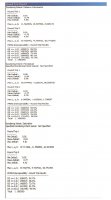- Joined
- Jan 4, 2012
- Messages
- 1,675
- Reaction score
- 1,309
- Points
- 277
- Location
- UK
- Printer Model
- Canon Pro9000 II
In a profile Round Trip assessment am I right in assuming that Maximum Delta E should be less than integer value 6, to acceptable?
I seem to be finding some profiles with much higher values, (20 to 50 in some rendering intents),
and in one case 90 in a profile that produced very poor results.
PRMG Interoperability Round Trip Results seem to expect a wider range of values of DE up to 10.
Any guidance would be appreciated.
I seem to be finding some profiles with much higher values, (20 to 50 in some rendering intents),
and in one case 90 in a profile that produced very poor results.
PRMG Interoperability Round Trip Results seem to expect a wider range of values of DE up to 10.
Any guidance would be appreciated.

